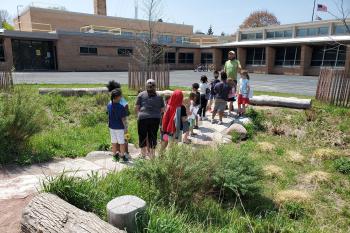Objective, Commitments & Measures
Objective:
3.2. Reduce or prevent stormwater runoff to improve and sustain water quality.
Commitments:
3.2.a. Increase implementation of green infrastructure practices in communities impacted by polluted runoff.
3.2.b. Implement projects in urban and rural communities designed to reduce or prevent runoff, flooding and erosion.
Measures:
| Measures of Progress With Annual Targets | Baseline/ Universe | FY2025 Target | FY2026 Target | FY2027 Target | FY2028 Target | FY2029 Target |
|---|---|---|---|---|---|---|
| 3.2.1. Estimated gallons (in millions) of stormwater runoff reduced. | 550/N/A | 625 | 700 | 775 | 850 | 925 |
| 3.2.2. Miles of Great Lakes streams and shoreline restored or protected. | 61/N/A | 74 | 87 | 100 | 113 | 126 |
| 3.2.3 Acres of riparian buffers, wetlands and floodplains restored or reconnected. | 0/N/A | 50 | 100 | 150 | 200 | 250 |
"Targets" are cumulative. "Baseline" for Measures 3.2.1 and 3.2.2 are the target values for 2024 set in Action Plan III. "Baseline" for Measure 3.2.3 is 0 because this is a new measure for Action Plan IV.
Background
GLRI-funded projects have prevented more than 500 million gallons of untreated urban stormwater runoff from entering the Great Lakes. In addition, more than 300 local watershed projects have been implemented in Great Lakes communities and more than 60 miles of streams and shoreline protected through nature-based methods.
Since GLRI began, GLRI federal agencies and their partners have reduced the loading of sediment, nutrients, toxic contaminants and pathogens to Great Lakes tributaries and nearshore waters from stormwater runoff. GLRI funding supported green infrastructure projects in Great Lakes communities to reduce untreated stormwater runoff and to improve nearshore water quality. These green infrastructure projects have the added benefit of increasing greenspace in urban areas, offering flood mitigation and providing habitat for pollinators.
Under GLRI Action Plan IV, GLRI federal agencies and their partners will continue to encourage and accelerate implementation of projects to reduce or prevent stormwater runoff to protect nearshore water quality. GLRI federal agencies and partners will continue to support green infrastructure practices to capture or slow the flow of untreated runoff and filter out sediment, nutrients, toxic contaminants, pathogens and other pollutants from runoff before it reaches the Great Lakes, with a focus on communities impacted by polluted runoff.
These projects may also provide flood mitigation benefits by reducing peak flows. Projects may require maintenance to handle increasingly intense rain events. GLRI agencies and partners will consider projected future stormwater volumes in the design of projects.
GLRI federal agencies will continue to work with public-private partnerships such as the Southeast Michigan Resilience Fund and the Chi-Cal Rivers Fund to leverage GLRI investments in communities for delivering on-the-ground projects where they make a difference. GLRI federal agencies and partners will also continue to support watershed-based, collaborative approaches that bring urban and rural communities together to address water quality concerns.
Actions such as reconnecting a floodplain to a stabilized vegetated streambank can help increase a stream’s resilience to stressors such as large storms. Restoration projects along coastlines can incorporate nature-based features to mitigate effects of more extreme storms, high wave action, interrupted sediment transport and presence of man-made physical structures. Activities to reduce stormwater runoff and streambank erosion also complement these restoration efforts and increase coastal resiliency. These efforts will protect over a hundred miles of Great Lakes streams and shoreline, restore and reconnect riparian buffers along streams and filter hundreds of millions of gallons of stormwater runoff.
Continue reading about the Action Plan IV:




